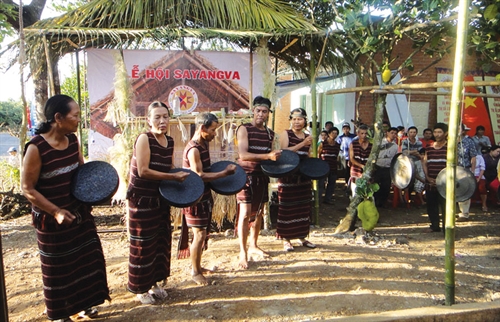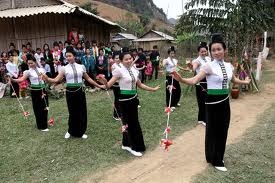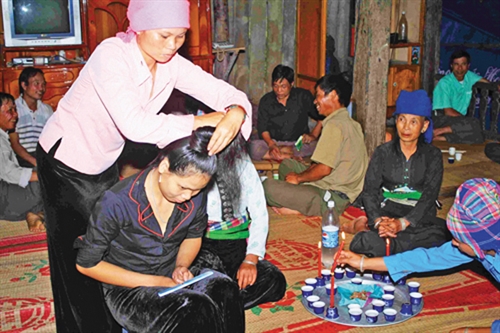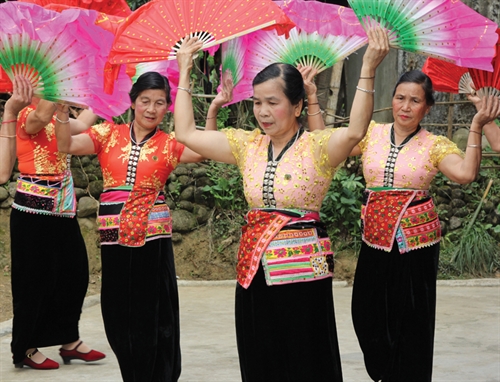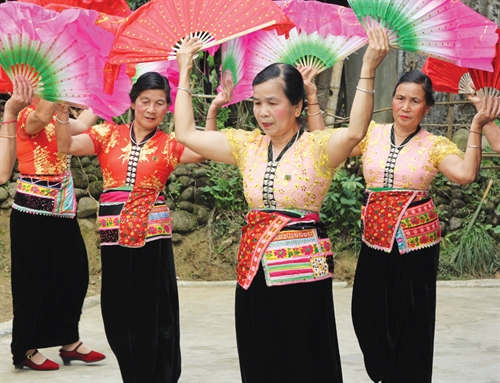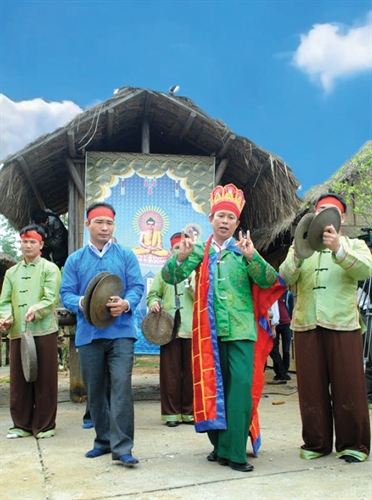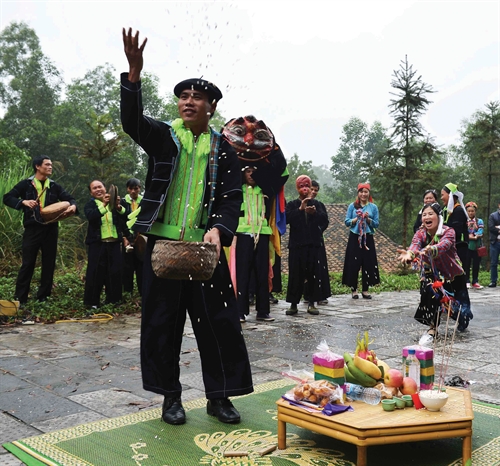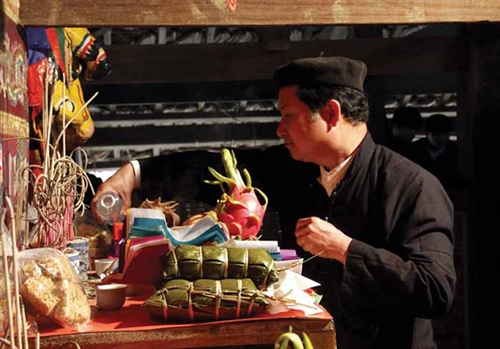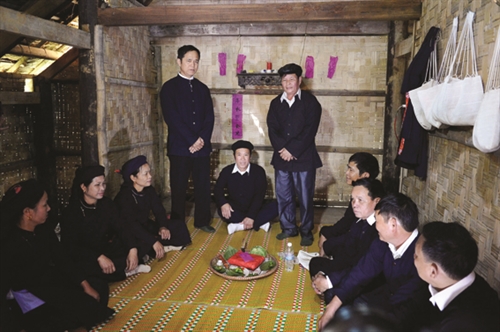Ta Thi Tam
Ethnology Institute
Like other ethnic groups living in Truong Son - Tay Nguyen (Long Mountain - Highlands) region, the K’ho, also known as Co Ho or Ko Ho, practice polytheism, worshipping multiple “yang” (deities). This originates from the primitive perception of people who lead a poor life dependent on nature and always affected with diseases and therefore need the support of many deities.
According to the K’ho people, their peaceful and happy life with bumper crops and unity within their villages and families are owed to the support of “yang”; hence, they must show gratitude to them. They believe that “yang” will cause droughts, floods or crop failures as punishments to villages where wrongdoings are committed.
The K’ho worship Yang Koi (the rice deity), Yang Da (the water deity), Yang Pnom (the mountain deity) Yang Chi (the plant deity), Yang U Tiah (the land deity), Yang Mat To Ngai (the sun deity), and Yang Pit (the thunder deity), Yang Miu (the rain deity). These “yang” are closely associated to wet rice agriculture, which plays the crucial role throughout the history of this ethnic group. They are convinced that after every worship with offerings, “yang” will support and protect them, bringing them bumper crops. They never blame the deities for crop failures due to natural disasters or pests but only blame themselves for their wrongdoings. Therefore, the K.Hor organize different rites for different stages of the rice growth cycle, from seed sowing to rice harvesting and storage.
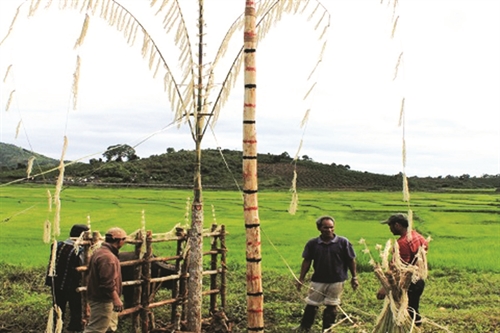 |
| Tying a buffalo for sacrifice for the rice-earing rite of the K’ho Sre in Lam Dong province__Photo: Internet |
Rice seed-sowing rite
This is the rite starting the wet rice cultivation cycle. It is held around June and July, depending on the early or late appearance of water.
The rite is practiced right at the rice field, where the house master pours rice sprouts on a bamboo lattice panel, plants a bamboo pole, arranges a jar liquor and a chicken, then prays: “Deities, today I sow rice seeds on fertile fields, big and small, and pray deities not to cause heavy rains and floods which ruin my rice seeds.” Stopping the pray, the house master mixes the rice seeds with chicken blood and sliced taro stems and leaves, then sow these seeds. The K’ho believe that sliced taro stems and leaves will scare birds and mice away from rice seeds as eating such rice seeds will cause an itching throat. They also believe that the taro leaves can protect rice seeds from heavy rain.
After finishing sowing rice seeds, people will wash themselves and come to the house of the rice field owner for a small party, drinking liquor, eating chicken and beating gongs until midnight for the successful rice seed sowing.
Buffalo foot-washing rite
The buffalo foot-washing rite is held about one month after the seed-sowing rite, aiming to wash away all tiredness and hardships experienced by buffaloes during the plowing time and to pray deities for strength and fertility to buffaloes.
This rite is practiced in each family’s house. The house master erects a bamboo pole at the door of the buffalo stable, and plants taro, saffron and weed around the buffalo stable. When the night falls, the house master prays at the buffalo stable, kills a chicken right there and pours chicken blood into a copper crock to be left at the door of the buffalo stable as chicken blood symbolizes medicine to cure buffalo diseases. Then, worshipping rituals are practiced inside the house, where all fires must be stamped out to ward off diseases and deaths caused to buffaloes by devils. By the liquor jar, the house master puts a bamboo section soaked in water and liquor and a ploughshare for every family member to rub the water on his or her chest seven times, implying that after experiencing hardships during the plowing time, people should not waste the rice and eat too much like the ploughshares eat the soil. At dawn the next day, a family member gets up early, brings liquor to the stable for the buffaloes to drink and sprays liquor dregs on their backs before letting them out for grazing. On that day, the buffalo tenders must neither beat nor scold the buffaloes but treat them kindly.
Paddy-nurturing rite
This is a big, collective rite as it involves the entire village. It is an important event in the wet rice cultivation cycle for the K’ho to express their thanks to the deity who has created the rice strains and taught them to grow wet rice and brought a favorable weather for the rice to develop well.
During a rice season, according to the K’ho, there are many things related to rice plants and grains which must be abstained from. Disregarding rice is disrespect for the rice deity. All acts related to the rice must be tender and careful, not letting grains drop on the ground. The rite is also an occasion to remind every villager of to be-abstained things related to the rice deity.
The rite is organized in around September, when rice fields turn green and lush with rice plants growing high above the field banks. The place for holding the event is usually at the foot of a hill in front or the rear of the village, or at a common water well of a family line if it is organized by family lines.
In preparation for this rite, each family line chooses a vacant land area where they build a small house or a tower for deities called the abstention or deity house, which is used only once a year for deity worshiping. After the event, such house can be used for villagers to take short rests after working in the fields or traveling a long journey. The house is also a place for the aged persons in the family line to discuss family affairs or receive guests and for keeping offerings.
One month before the rite, villagers renovate their houses, clean village roads, build a house for the rice deity, and erect worshiping scaffolds. One day before the official ritual, the K’ho hold a ceremony to tie buffaloes to the worshiping scaffolds. At night, all strong young men and women gather to beat gongs and drums, blow bugles and flutes and drink liquor to prevent beasts from killing the buffaloes and causing troubles to the rite.
On the official ritual day, the ceremony master kills a small chicken for worship and prays to the rice deity for bumper crops, peace, good health and prosperity to all villagers. He also invites the deity to accept the offerings and join the villagers on the day. Then comes the buffalo-stabbing ceremony. While the ceremony master performs different ceremonies with buffalo blood, villagers use bamboo sections to store buffalo blood together with some liquor dregs and put alang-alang grass stems into the blood. Then they spread to all directions and plant such alang-alang grass stems in their own rice fields to express their wish for the strong growth of rice plants like the alang-alang grass. The good buffalo meat pieces are put on the scaffold as offerings to the deity, while the rest is cooked in preparation for the village party.
Rice-earing rite
This rite is organized at a time when the rice plants have formed ears, aiming to pray the rice deity for succulent ears with abundant grains, which will not be harmed by birds, mice and beasts. It is practiced by all families on their rice fields, usually on the full-moon day, in a hope that their crops and life will be as full as the moon of the fifteen day of a lunar month. The house master erects a bamboo pole at the ritual place, kills a chicken and pours its blood into a bamboo section with water and cooked rice symbolizing a chicken blood porridge to nurture rice grains. Concluding the rite, the family head spreads such porridge with his hands on his family’s rice fields.
Rice-ripening rite
When the rice turns yellow, the K’ho people organize a rice-ripening rite. The rice field owner erects in the rice field a bamboo pole of over 10 m high and a tower as home for “yang”. He stands in front of the bamboo pole, praying “yang” to keep birds, mice and beasts from taking the rice grains away. Hung on the bamboo pole is an eagle effigy and a bamboo fish pot with a small lump of earth (implying that the rice grains will be as many as sand grains and as heavy as the earth lump). A tray of cooked rice, sticky rice, banana, chicken egg, liquor and chicken is laid in the tower. Doing so, according to the K’ho, will help the deities know the way to return and enjoy the offerings.
On this occasion, K’ho people also plant at both ends of their rice field small bamboo-woven eagle effigies tied with a bamboo tocsin, prepare a mat and a small cage with sticky rice inside for the deity to sleep and eat to watch the rice.
Rice-reaping rite
When all the rice plants ripen, the rice field owner drains off all water from the field for easy rice harvest, then holds a rice-reaping rite. He selects rice plants with long ears and big grains, cuts a handful of such plants, ties them together into a bundle, then applies chicken blood to them and decorates them with chicken wing feathers and liquor dregs. After doing so, he starts praying: “I once prayed to the deity for rice plants to well develop with steady stems and solid grains; now that the rice plants ripen and are cut and piled up, I kindly beg the deity not to cause rains which will destroy the newly harvested grains.”
As soon as the field owner stops praying, people start reaping the rice then pile them in heaps. Twenty days later, a fence is erected around the rice heaps and buffaloes are brought into for stamping on rice plants to separate grains from straw.
Rice-winnowing rite
Before winnowing the rice, offerings are put onto the rice heap, including a liquor jar, a cup of water, a bowl of rice, a bowl of sticky rice, a chicken egg, a bunch of bananas, a smoked pig, a bowl of chicken’s and pig’s chitterlings, and a broom. When the worship is over, people start pounding the rice. In carrying rice home, the house master must carry the first and the last rice baskets. Before going home, the house master prays that all rice grains still left in the field will themselves return to the rice barn.
Rice basket-covering rite
This is the final rite in a wet rice cultivation cycle of the K’ho people, which takes place around March and April every year when field work finishes, rice has stayed in the barns and liquor jars are ready for drink. This is a ceremony for covering rice baskets, aiming to express thanks to the deities who have bestowed villagers an abundant and happy life, favorable weather, bumper crop and good health.
The rice basket-covering rite marks the closure of a hard crop and the opening of a new hopeful one, which is considered by the K’ho people their own new-year festival. It reflects the feelings and aspirations of an ethnic group practicing polytheism and wet rice agriculture as their main livelihood.-
